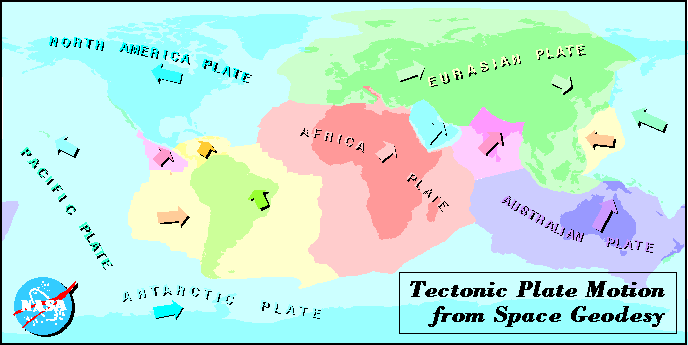
Web Standards to the rescue. One NASA Look and Feel CSS TEMPLATES
Two Columns
Tectonic Plate Motion

Diagram of global plate motion.
Tectonic motion for points around the world can be estimated from a variety of space geodetic technologies (e.g., Satellite Laser Ranging (SLR), Very Long Baseline Interferometry (VLBI), Global Positioning System (GPS) among others). In this web-page, the focus is on the results from SLR. With over 15 years of laser tracking data acquired by a network of globally distributed sites, variations in site positions can be monitored through time. The motions of the plates are largely slow and smooth in nature, with the exception of regions where earthquake activity is high. In these regions, significant surface displacements over a very short time period can and do occur. The results you will find here only represent the generally slow and smooth nature of tectonic motion - displacements directly attributable to earthquakes may not be evident in these results.
Below, you will find an index map for the regions of the world for which there are SLR site motion results. Unfortunately, for a variety of socio-economic and political reasons, the entire world is not uniformly covered by SLR observatories. If you're interested, you might try the links to VLBI and GPS to discover the parts of the world sampled by those technologies. For the SLR results, use the links below the map to view the SLR estimates of site motions for locations within these regions.

Map of Satellite Laser Ranging site velocity maps. Click on highlighted areas or geographic area links: Europe | Far East, Australia, and Pacific | North America | Nazca and South America.
For Further Information
The yearly GSFC SLR submissions to the IERS are available through the CDDIS. For more information about Space Geodesy at GSFC, please view the Space Geodesy Branch website. More information the terrestrial reference frame can be found at the IERS and ITRF websites.
Acknowledgment
The authors would like to acknowledge the contributions of our colleague John Robbins in the original implementation of this information on the web.
SLR Tectonic Maps
- Responsible NASA Official: Ben Chao
- Web Content: Mark Torrence
- Website Manager: Carey Noll
- Last Updated: October 2, 2008
